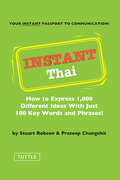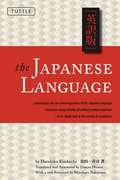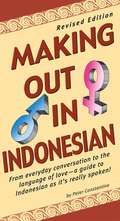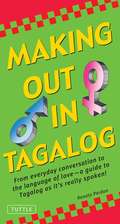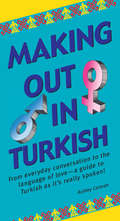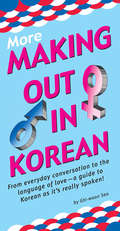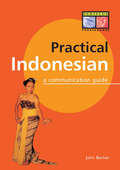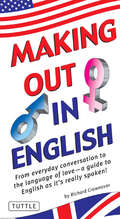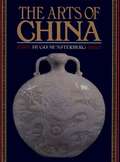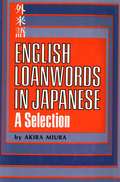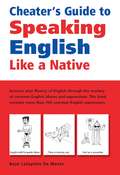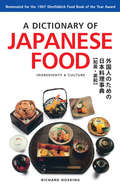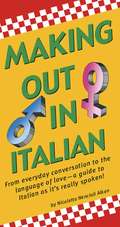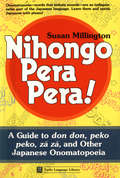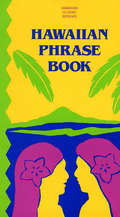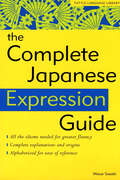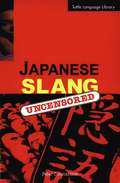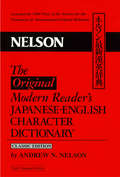- Table View
- List View
Instant Thai: How to Express 1,000 Different Ideas with Just 100 Key Words and Phrases! (Thai Phrasebook)
by Stuart Robson Prateep ChangchitIt's amazing how 100 key words and phrases provide instant communication!Do you want to speak simple Thai but are too busy to study it? Are you visiting Thailand for a short time and want a Thai phrase book to help you communicate? If so, this is the book for you. It includes all the necessary information to speak basic Thai.The idea of Instant Thai is simple-learn 100 words and phrases and say 1,000 things. The trick is knowing which 100 words to learn, but the authors Stuart Robson and Prateep Changchit have solved the problem, choosing only those words you'll hear again and again. Even with a vocabulary this small, you'll be surprised how quickly and fluently you too can communicate in Thai. It also has an English-Thai wordlist, arranged alphabetically. At the end of the book are useful appendices for telling the time, kinship terms, some Thai proverbs, and emergency expressions. Here's a sample of what you'll be able to do:Meet peopleGo shoppingAsk directionsRide the subwayOrder food and drinksAnd much more
Instant Thai: How to Express 1,000 Different Ideas with Just 100 Key Words and Phrases! (Thai Phrasebook)
by Stuart Robson Prateep ChangchitIt's amazing how 100 key words and phrases provide instant communication!Do you want to speak simple Thai but are too busy to study it? Are you visiting Thailand for a short time and want a Thai phrase book to help you communicate? If so, this is the book for you. It includes all the necessary information to speak basic Thai.The idea of Instant Thai is simple-learn 100 words and phrases and say 1,000 things. The trick is knowing which 100 words to learn, but the authors Stuart Robson and Prateep Changchit have solved the problem, choosing only those words you'll hear again and again. Even with a vocabulary this small, you'll be surprised how quickly and fluently you too can communicate in Thai. It also has an English-Thai wordlist, arranged alphabetically. At the end of the book are useful appendices for telling the time, kinship terms, some Thai proverbs, and emergency expressions. Here's a sample of what you'll be able to do:Meet peopleGo shoppingAsk directionsRide the subwayOrder food and drinksAnd much more
Instant Thai
by Prateep Changchit Stuart RobsonIt's amazing how 100 key words and phrases provide instant communication!Do you want to speak simple Thai but are too busy to study it? Are you visiting Thailand for a short time and want a Thai phrase book to help you communicate? If so, this is the book for you. It includes all the necessary information to speak basic Thai.The idea of Instant Thai is simple-learn 100 words and phrases and say 1,000 things. The trick is knowing which 100 words to learn, but the authors Stuart Robson and Prateep Changchit have solved the problem, choosing only those words you'll hear again and again. Even with a vocabulary this small, you'll be surprised how quickly and fluently you too can communicate in Thai. It also has an English-Thai wordlist, arranged alphabetically. At the end of the book are useful appendices for telling the time, kinship terms, some Thai proverbs, and emergency expressions. Here's a sample of what you'll be able to do:Meet peopleGo shoppingAsk directionsRide the subwayOrder food and drinksAnd much more
The Japanese Language
by Haruhiko Kindaichi Umeyo Hirano Mineharu NakayamaThis is a book about the structure, history and evolution of the Japanese languageThe Japanese Language is a classic study of one of the world's most widely used but least understood languages. Emphasizing the richness and complexity of Japanese as well as its limitations, this fine book provides a lively discussion about the uniqueness of the Japanese language.This book will interest anyone intrigued by one of the word's most widely used and least understood languages. The relationship of Japanese to other languages is not well understood even by native speakers, and Proffessor Kindaichi sets out to define it. He concludes that Japanese is indeed only remotely related to other world languages although it shares many features in common with the languages of mainland AsiaReaders who are just beginning Japanese study will find this section especially fascinating, for each point is backed by examples from literature and everyday speech. Kindaichi also investigates the so-called vagueness of Japanese and traces it to its source-the unusual sentence order. This book includes:The highly debated origins of the Japanese languageDialects, jargon, sex- and role-based distinctionsDifferences between informal, formal, and literary langaugeStructure, rhythm, and accent of pronunciationWhat can and cannot be said in Japanese
The Japanese Language
by Umeyo Hirano Haruhiko Kindaichi Mineharu NakayamaThis is a book about the structure, history and evolution of the Japanese languageThe Japanese Language is a classic study of one of the world's most widely used but least understood languages. Emphasizing the richness and complexity of Japanese as well as its limitations, this fine book provides a lively discussion about the uniqueness of the Japanese language.This book will interest anyone intrigued by one of the word's most widely used and least understood languages. The relationship of Japanese to other languages is not well understood even by native speakers, and Proffessor Kindaichi sets out to define it. He concludes that Japanese is indeed only remotely related to other world languages although it shares many features in common with the languages of mainland AsiaReaders who are just beginning Japanese study will find this section especially fascinating, for each point is backed by examples from literature and everyday speech. Kindaichi also investigates the so-called vagueness of Japanese and traces it to its source-the unusual sentence order. This book includes:The highly debated origins of the Japanese languageDialects, jargon, sex- and role-based distinctionsDifferences between informal, formal, and literary langaugeStructure, rhythm, and accent of pronunciationWhat can and cannot be said in Japanese
Making Out in Indonesian: Revised Edition (Indonesian Phrasebook)
by Soe Tjen Marching Peter ConstantineMaking Out in Indonesian is a fun, accessible and thorough guide to Indonesian as it's really spoken. It has been updated and expanded to be even more helpful as a guide to modern colloquial Indonesian for use in everyday informal interactions-giving access to the sort of catchy expressions that aren't covered in traditional language materials.<P><P>It includes an introduction to the Indonesian language as well as a pronunciation guide, topical notes throughout on key points of language and culture, and chapters based on typical real-life encounters with speakers of Indonesian, including: o Making acquaintances o Discussing likes and dislikes o Sharing a meal o Going out on the town o Developing a romantic relationship or quarreling, even through to having sex and getting married or splitting up!
Making Out in Tagalog: (Tagalog Phrasebook)
by Renato PerdonMaking Out in Tagalog is a fun, accessible and thorough Tagalog phase book and guide to the Filipino language as it's really spoken.<P><P>If you are a student, businessman or tourist traveling to the Philippines and would like to have an authentic and meaningful experience, the key is being able to speak like a local. This friendly and easy-to-use Tagalog phrasebook makes this possible. Making Out in Tagalog has been carefully designed to act as a guide to modern colloquial Tagalog for use in everyday informal interactions-giving access to the sort of catchy Filipino expressions that aren't covered in traditional language materials. Each expression is given in Tagalog, so that in the case of difficulties the book can be shown to the person the user is trying to communicate with.This Tagalog phrasebook includes:A guide to pronouncing Tagalog words correctly including vowel combinations and stressing of wordsExplanations of basic Tagalog grammar, such as, word order, pronouns, borrowed words, and polite vs. impolite tensesUseful and interesting notes on Tagalog language and Filipino cultureLots of colorful, fun and useful expressions not covered in other phrasebooks
Making Out in Turkish: Turkish Phrasebook
by Ashley CarmanMaking Out in Turkish is a fun, accessible and thorough Turkish phrase book and guide to the Turkish language as it's really spoken.Sana hayranim! Seni tekrar ne zaman gorecegim?--(I adore you! When can I see you again?) Answer this correctly in Turkish and you may be going on a hot date.<P><P> Incorrectly, and you could be hurting someone's feelings or getting a slap! Turkish classes and textbooks tend to spend a lot of time rehearsing for the same fictitious scenarios but chances are while in Turkey you will spend a lot more time trying to make new friends or start new romances--something you may not be prepared for.If you are a student, businessman or tourist traveling to Turkey and would like to have an authentic and meaningful experience, the key is being able to speak like a local. This friendly and easy-to-use Turkish phrasebook makes this possible. Making Out in Turkish has been carefully designed to act as a guide to modern colloquial Turkish for use in everyday informal interactions--giving access to the sort of catchy Turkish expressions that aren't covered in traditional language materials. Each expression is given in authentic Turkish (turkce) so that in the case of difficulties the book can be shown to the person the user is trying to communicate with. In addition, phonetic spellings are also included making speaking Turkish a breeze. For example "Okay"--Tamam, is also given as ta-MAHM. This Turkish phrasebook includes:A guide to pronouncing Turkish words correctlyExplanations of basic Turkish grammar, such as, double letters, vowel harmony, agglutination, questions, and negationComplete Turkish translations including phonetic spellingsUseful and interesting notes on Turkish language and cultureLots of colorful, fun and useful expressions not covered in other phrasebooksTitles in this unique series of bestselling phrase books include: Making Out in Chinese, Making Out in Indonesian, Making Out in Thai, Making Out in Korean, Making Out in Hindi, Making Out in Japanese, Making Out in Vietnamese, Making Out in Burmese, Making Out in Tagalog, Making Out in Hindi, Making Out in Arabic, Making Out in English, More Making Out in Korean, and More Making Out in Japanese.
More Making Out in Korean: (Korean Phrasebook)
by Ghi-Woon SeoMore Making Out in Korea is a fun, accessible and thorough Korean phrase book and guide to the Korean language as it's really spoken.<P><P>This prasebook follows the bestselling Making Out in Korea providing additional (and classic) phrases for travelers, including ones to help you make acquaintances, discuss likes and dislikes, share a meal, go out on the town or develop a romantic relationship.This Korean phrasebook includes: A guide to pronouncing Korean words correctly. Explanations of basic Korean grammar, such as, word order, questions, and formal vs. informal tenses. Complete Korean translations including Korean Script (hangul). Useful and interesting notes on Korean language and culture. Lots of colorful, fun and useful expressions not covered in other phrasebooks.
Practical Indonesian Phrasebook: A Communication Guide
by John BarkerThis is a handy, travel-sized Indonesian phrasebook with additional information about the Indonesian language.<P><P>As any seasoned traveler knows, the ability to communicate in the language of the country you are visiting makes a very big difference in the experiences you have. Even a basic grasp of a few essentials will help you to relate to the people, get where you want to go, pay the right prices, and get much more out of your visit. That's the reason for this book which is designed especially for travelers to Indonesia and Malaysia. The emphasis is on effective communication, not grammar rules or tourist phrases. It is organized to be as simple, concise, and useful as possibly. With this book and a few hours of practice you can start communicating in Indonesian or Malay.The main focus of the book is Indonesia and Indonesian. However, since Malay is very closely related language, you will be able to make use of it quite effectively in both countries. Key features of Practical Indonesian Phrasebook are:Very compact travel sizeHundreds of useful Indonesian words and phrasesArranged by topic and situation for easy useIndonesian grammar, pronunciation and body-language guidesGlossary and appendix for easy reference and conversion to Malay
Making Out in English
by Richard CrownoverMaking Out in English is a fun, accessible and thorough English phrase book and guide to the English language as it's really spoken.If you are a student, businessman or tourist traveling to the English speaking world and would like to have an authentic and meaningful experience, the key is being able to speak like a local. This friendly and easy-to-use English phrasebook makes this possible. Making Out in English has been revised and redesigned to act as a guide to modern colloquial English for use in everyday informal interactions-giving access to the sort of catchy English expressions that aren't covered in traditional language materials. In the case of difficulties the book can be shown to the person the user is trying to communicate with.This English phrasebook includes:A guide to pronouncing English words correctlyExplanations of basic English grammarComplete translationsUseful and interesting notes on the English language and cultureLots of colorful, fun and useful expressions not covered in other phrasebooks
Making Out in English
by Richard CrownoverMaking Out in English is a fun, accessible and thorough English phrase book and guide to the English language as it's really spoken.If you are a student, businessman or tourist traveling to the English speaking world and would like to have an authentic and meaningful experience, the key is being able to speak like a local. This friendly and easy-to-use English phrasebook makes this possible. Making Out in English has been revised and redesigned to act as a guide to modern colloquial English for use in everyday informal interactions-giving access to the sort of catchy English expressions that aren't covered in traditional language materials. In the case of difficulties the book can be shown to the person the user is trying to communicate with.This English phrasebook includes:A guide to pronouncing English words correctlyExplanations of basic English grammarComplete translationsUseful and interesting notes on the English language and cultureLots of colorful, fun and useful expressions not covered in other phrasebooks
Making Out in English
by Richard CrownoverMaking Out in English is a fun, accessible and thorough English phrase book and guide to the English language as it's really spoken.If you are a student, businessman or tourist traveling to the English speaking world and would like to have an authentic and meaningful experience, the key is being able to speak like a local. This friendly and easy-to-use English phrasebook makes this possible. Making Out in English has been revised and redesigned to act as a guide to modern colloquial English for use in everyday informal interactions-giving access to the sort of catchy English expressions that aren't covered in traditional language materials. In the case of difficulties the book can be shown to the person the user is trying to communicate with.This English phrasebook includes:A guide to pronouncing English words correctlyExplanations of basic English grammarComplete translationsUseful and interesting notes on the English language and cultureLots of colorful, fun and useful expressions not covered in other phrasebooks
The Arts of China
by Hugo MunsterbergThe arts of China are products of the world's oldest continuous artistic tradition as well as one of its most brilliant. In this stimulating work, noted Oriental art authority Dr. Hugo Munsterberg traces the history of Chinese art dynasty by dynasty, elucidating the origins and development of major movements in painting, ceramics, bronzes, sculpture, and architecture. He clearly describes and defines the important trends and influences that culminated in the brilliant sculpture of the T'ang, the enchanting landscape paintings of the Sung, and the exquisite ceramics of the Ming. Outstanding examples of each genre are presented in over one hundred superb color and black-and-white photographs.
English Loanwords in Japanese
by Akira MiuraToriningu-pantsu are not training pants for babies who have not yet been toilet-trained. Toreningu-pantsu are sweat pants. When you jump into a swimming pool you will get wet, but not necessarily uetto. Volleyball, which was invented in the United States, is known as bareboru in Japan, but the tennis volley was the English gentleman's pride before it was America's . A tennis volley is therefore pronounced in British style, bore, not as American bare. Oru means "all" but has a more limited usage. Bosu is often used more negatively than English boss.Many people imagine that speakers of English who study the Japanese language find their way eased by the profusion of "English words" the Japanese have borrowed. Students of the language, however, often complain that borrowed words are more problematic than the older terms in the Japanese word pool.One of the biggest problems is the lack of adequate reference materials on the terms. Many of the existing works do little more than define the terms. This book handles the problematic areas. Here a reader will find sample sentences, tips on usage, and warnings against easy-to-commit mistakes. There are fascinating studies of how certain "English" terms were coined in Japan and of what led the Japanese to redefine certain common English words. Miura examines how certain words entered Japanese, and why they became popular.He theorizes on why an unexpected pronunciation developed. In discussing the borrowed terms, the author draws on many linguistic scholars, discusses prevailing beliefs on etymology and pronunciation, and uses his own considerable experience with both English and Japanese to help the student gain control of some of the most problematic words borrowed by J apanese from English . Each of the 850 words discussed under the text's more than 350 main headings is included in a n index for quick reference. The detail and currency of the explanations contained in this book are unmatched by other books on the subject. For the student hard put to use these borrowed words, this text offers real help.
Cheater's Guide to Speaking English Like a Native
by Boye Lafayette De MenteIncrease your fluency of English through the mastery of common English idioms and expressions.All Native English-speakers use a large number of proverbs and colloquial expressions in their daily conversations. These common sayings, which evolved over the centuries, are like "codes" that reveal the cultural values and attitudes of the speakers.To obtain complete fluency in the English language it is necessary to be familiar with these expressions and know how and when to use them.With a user-friendly format, The Cheater's Guide to Speaking English like a Native is a shortcut to achieving that goal.
A Dictionary of Japanese Food: Ingredients & Culture
by Richard HoskingNominated for the Glenfiddich Food Book of the Year Award, this timeless volume is the first and only book of its kind on the subject.<P><P>A Dictionary of Japanese Food helps food lovers around the world decipher the intricacies and nuances of Japanese cooking and its ingredients. Definitions in ordinary cookbooks and standard dictionaries--such as akebia for akebi, sea cucumber for namako, plum for ume--can be inadequate, misleading, or just plain wrong. Richard Hoskings eliminates the mystery by ensuring that each entry in the Japanese-English section includes the Japanese term in Roman script; the term in kana or kanji or both; a Latin name where appropriate; an English definition; and, for most entries, a short annotation.The English-Japanese section defines important English food terms in Japanese and annotates those needing explanation. One hundred small line drawings make it easy for readers to identify everything from mitsuba to the okoze fish, and seventeen appendices address the most critical elements of Japanese cuisine, from the making of miso and the structure of the Japanese meal to the tea ceremony.
Making Out In Italian: (Italian Phrasebook)
by Nicoletta Nencioli AikenMaking Out in Italian is a fun, accessible and thorough Italian phrase book and guide to the Italian language as it's really spoken.This friendly and easy-to-use Italian phrasebook makes this possible.<P><P> Making Out in Italian has been carefully designed to act as a guide to modern colloquial Italian for use in everyday informal interactions-giving access to the sort of catchy Italian expressions that aren't covered in traditional language materials. Each expression is given in Italian so that in the case of difficulties the book can be shown to the person the user is trying to communicate with. In addition, phonetic spellings of all words and phrases are included, making speaking Italian a breeze. For example, "Hi!"-ciao is also written as chah-oh.This Italian phrasebook includes:A guide to pronouncing Italian words correctly including double consonants and syllable stressesExplanations of basic Italian grammar, such as, questions, word gender, and formal vs. informalComplete Italian translations for all words and phrases including easy-to-use phonetic spellings.Useful and interesting notes on Italian language and cultureLots of colorful, fun and useful expressions not covered in other phrasebooks
Nihongo Pera Pera !
by Susan MillingtonOnomatopoeia-words such as "glug glug," "pow," and "splash" in English- are an integral part of Japanese. Japanese people draw on a wealth of onomatopoeiato express subtle feelings, images, sounds, and actions. With this book you too can become pera pera - fluent- in Japanese, speaking with clarity and flair.Four hundred entries covering everything from food to weather provide clear definitions and helpful example sentences. With an overview of the use andhistory of onomatopoeic expressions, Nihongo Pera Pera! offers a systematic and entertaining approach to learning an essential part of Japanese. Add these expressions to your vocabulary and dramatically improve your ability to express yourself. A must for both serious and casual learners, Nihongo Pera Pera!is your key to fluency.
Nihongo Pera Pera !
by Susan MillingtonOnomatopoeia-words such as "glug glug," "pow," and "splash" in English- are an integral part of Japanese. Japanese people draw on a wealth of onomatopoeiato express subtle feelings, images, sounds, and actions. With this book you too can become pera pera - fluent- in Japanese, speaking with clarity and flair.Four hundred entries covering everything from food to weather provide clear definitions and helpful example sentences. With an overview of the use andhistory of onomatopoeic expressions, Nihongo Pera Pera! offers a systematic and entertaining approach to learning an essential part of Japanese. Add these expressions to your vocabulary and dramatically improve your ability to express yourself. A must for both serious and casual learners, Nihongo Pera Pera!is your key to fluency.
Hawaiian Phrase Book
by Charles E. Tuttle Company, Inc.Originally, the primary object of this manual was to teach natives to converse in English. At the same time, the work is designed to assist strangers, speaking English, to acquire the correct colloquial speech of the Hawaiians.
The Complete Japanese Expression Guide
by Mizue SasakiA companion volume to The Complete Japanese Verb Guide andThe Complete Japanese Adjective Guide, with over 600 idioms.The Complete Japanese Expression Guide enables students to speak and understand idiomatic Japanese with the ease and fluency of a native speaker. For the first time ever, over 600 of the most commonly used idiomatic expressions in the Japanese language have been brought together and alphabetized in a single, convenient volume. No longer will the student have to rely on stuffy academic-sounding phrases and expressions. Mizue Sasaki has successfully taken stilted formality out of Japanese, and made natural, idiomatic communication readily possible. This handy volume not only introduces essential idioms, but also provides easy-to-understand translations and numerous example sentences to show how the expressions should be used. Studying colloquial Japanese doesn't have to be hitori-zumo, a futile effort (page 94). With The Complete Japanese Expression Guide, fluency is guaranteed.
Japanese Slang
by Peter ConstantineReveals, in vivid detail, the richness of Japanese slang in all its amusing, bizarre and shocking forms.
Japanese Slang
by Peter ConstantineReveals, in vivid detail, the richness of Japanese slang in all its amusing, bizarre and shocking forms.
The Original Modern Reader's Japanese-English Character Dictionary
by Andrew M. Nelson"The Japanese government may someday recognize-- as it ought to--Tuttle's contribution to creating an intelligent interest in Japan among the English-reading public, and deepening understanding of Japanese overseas."--Hokubei Mainichi (San Francisco)Awarded the 1969 Prize for the Society of the Promotion of International Cultural Relations, this is the most comprehensive Japanese book of its kind. Containing Japanese-English and English-Japanese sections, it is an essential reference tool for serious students studying the Japanese language or for business people and tourists wishing to learn Japanese before they travel.Special features include: Lists over 5,000 carefully selected characters with their 10,000+ current readings and almost 70,000 compounds in current use, al with concise English definitions. Scientifically arranged by a logical extension of the traditional radical system so as to make the finding of a given character almost fool-proof, saving hours of time. Makes provision for quickly finding characters either in their traditional or their modern and often greatly altered forms, thus serving for both prewar and postwar literature. Includes 14 valuable appendices giving (1) instructions for the most efficient use of the book, (2) discussions of the written language in general and particularly of its recent and far-reaching official modifications, and (3) much helpful
